World War I Memorials and Cemeteries in Alsace
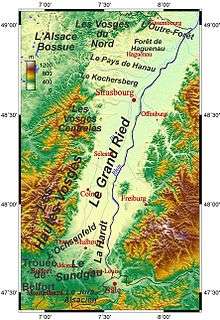
This is a list of World War 1 Memorials and Cemeteries in Alsace.
The Western Front ran across the Haute Alsace, across Le Bonhomme, passing Le Ligne, on near Munster, Reichackerkopf and Sondernach. It passed through the Petit Ballon and Grand Ballon before reaching Le Vieil Armand (Hartmannswillerkopf) and passing a line through Thann and Cernay. It then ran its course to Altkirch and the Sundgau and the Swiss border.
Background
While Alsace comprises the "départements" of Bas-Rhin and Haut-Rhin the front line just ran through the Haut-Rhin.
The fighting in this area in the 1914-1918 war can be divided into
- The Battles of Mulhouse and Dornach in August 1914.
- Fighting right along the line to partly define and establish that front line and then to defend or attack it. As part of this process great battles were fought at Linge and Hartmannwillerkopf both involving a heavy loss of life.
The Battles of Mulhouse and Dornach
| Description-The Battles of Mulhouse and Dornach |
|---|
| The Battle of Mulhouse (or Mülhausen) is also known as the Battle of Alsace. It began on 9 August 1914, and was the opening attack of the war. The offensive ended in failure, with a withdrawal on 10 August toward Belfort. The French were led by General Bonneau, whose "Army of Alsace" was made up of several units taken from the French 1st Army, namely the 7th Army Corps (14th and 41st infantry divisions reinforced by one brigade of the 57th reserve division from Belfort) and the 8th Cavalry division. On the German side the forces were part of Generaloberst Josias von Heeringen's 7th Army and comprised the XIVth and the XVth German Army Corps.
Building up to the Mulhouse battle, the French offensive had started on 7 August, with an attack in Haute-Alsace and the seizure of the border town of Altkirch and very soon Bonneau's troops had taken Mulhouse. The French success was short-lived however and the Germans retook the city on 10 August after reserves had been rushed down from Strasbourg. Joseph Joffre, the French Commander-in-Chief, had also despatched a reserve division to assist Bonneau but they had arrived too late to save Mulhouse from recapture. Bonneau withdrew towards Belfort, the only fort incidentally to have held out during the Franco-Prussian War, on 10 August in order to escape German encirclement. Bonneau's withdrawal to Belfort angered Joffre and he Immediately relieved him of his command. Joffre added four more divisions to the so-called 'Army of Alsace' and now placed it under the command of General Pau. All this was humiliating for the French but for a short time they had been euphoric and when they had entered Mulhouse, Joffre was moved to declare "CHILDREN of ALSACE! After forty-four years of sorrowful waiting, French soldiers once more tread the soil of your noble country. They are the pioneers in the great work of revenge. For them what emotions it calls forth, and what pride! To complete the work they have made the sacrifice of their lives. The French nation unanimously urges them on, and in the folds of their flag are inscribed the magic words, "Right and Liberty.". Long live Alsace. Long live France" The French were by no means finished with, despite the 10 August failure, and a counter-attack followed on 19 August in the wealthy Mulhouse suburb of Dornach which forced the Germans to retreat to Ensisheim, 20 km to the north. However, on 24 August the French again withdrew from Mulhouse and, in a short time, after an unsuccessful contribution to the fighting at Morhange-Sarrebourg. Pau’s army was dissolved and its troops deployed northwards to participate in the Battle of the Marne. Joffre sent Pau to join Bonneau in "retirement". When the French finally left Mulhouse, the front line was beginning to take shape and now ran roughly on a line from Pfetterhouse - Altkirch - Thann - Hartmannswillerkopf - Munster - Col du Linge- Col du Bonhomme. Only on 17 November 1918 were the French soldiers to march back into Mulhouse led by General Hirschauer. |
The course of the front line
We are dealing with a front line that starts to the south of St Die des Vosges and runs right down to the Swiss border. We shall cover the German cemetery south of Saulcy-sur-Meurthe, La Croix aux Mines, the Col du Bonhomme and the town of La Bonhomme as well as the French National cemetery at Duchesne. Next we will identify memorials and cemeteries in the area to the north and south of Orbey and the valley of Orbey. This will cover the Linge area, the memorial of Linge and the battle fought there, as well as covering memorials or cemeteries at Lapoutrie, Labaroche and Hohrod. We shall then deal with Munster and the area south of Munster and then the Hohneck peak and the Petit Hohneck. . We shall then look at the Grand Ballon and the Petit Ballon before proceeding to Guebwiller, Soultz, Moosch and Hartmannswiller finally dealing with Cernay, Thann, Altkirch and the Swiss border town of Pfetterhouse.
The French cemetery at Saulcy-sur-Meurthe
| The French cemetery at Saulcy-sur-Meurthe |
|---|
| Although actually in Lorraine, this cemetery is included in this listing as many of the soldiers buried here were killed fighting in nearby Alsace. The cemetery was created in 1921 and brought in bodies originally and provisionally buried in graves in the Col du Bonhomme, the Col de la Schlucht, Gérardmer, Mandray, Le Valtin and la Croix-aux-Mines. The cemetery holds the remains of 2,565 French soldiers of whom 1,174 are buried in two ossuaries. It has been claimed that the body of the soldier buried in Paris in the tomb of the unknown soldier came from grave 1405 in the Saulcy-sur-Meurthe cemetery.[1][2][3]
There is also a German cemetery at Saulcy-sur-Meurthe. |
French War cemetery at Carrefour Duchesne
| French War cemetery at Carrefour Duchesne |
|---|
| This cemetery is also known as "Tête des Faux". It contains the remains of 292 French soldiers in individual graves and another 116 who rest in an ossuary. The bodies here were brought in from Stosswihr, Orbey, Soultzeren and the Col du Bonhomme.
The slopes of the ridge at Linge, with its passes and peaks such as the Col du Wettstein and the Schratzmännele saw continuous fighting from mid February to mid October 1915 and it would be fair to say that the actual front line was not clearly defined before this period and until it finished. |
Monument in the French cemetery at Lapoutrie
| Monument in the French cemetery at Lapoutrie |
|---|
In Lapoutroie's French War cemetery is one of the many monuments to the Chasseurs that we will encounter in Alsace. The inscription reads "Passant souviens-toi de nos braves chasseurs libérateurs de 1914-18. Accordez Seigneur à tous pardon et paix" |
The Valley of Orbey, the Linge ridge and the surrounding district running south to Munster
The Col du Bonhomme
| Description of the Col du Bonhomme |
|---|
| At the opening of the 1914-1918 war, there was violent fighting in the Bonhomme pass and on 8 September 1914 a heavy German artillery bombardment killed several senior French officers including General Marie Désiré Pierre Bataille and there is a memorial in the area which commemorates this event. The memorial was inaugurated on 12 August 1939.
The village of Le Bonhomme itself suffered from artillery bombardments when the Germans were firing at the Tête-des-Faux. This is another area heavily fortified by the Germans and they constructed a tunnel on the Tête des Faux with a length of 1 kilometre, hewn from the rock of the mountain from the Corbeau Rock to the Mont Bonhomme peak. The village was occupied by French forces on 15 August 1914 and was later taken by the Germans. |
La Tête des Faux
| Description La Tête des Faux |
|---|
| The Tête des Faux is where the first large battle of the Vosges took place between December 1914 and February 1915. At 1,219 metres in height, the Tête des Faux dominates the villages of Bonhomme, Lapoutroie and Orbey as well as the pass at Bonhomme (Col du Bonhomme). It was considered as strategically important by the French and was the scene of some bloody fighting and is said to be the area where the Chasseur Alpins (Battalion Chasseur a Pied) were given their nickname of the "Diables bleus".
From August 1914, the Germans had installed themselves on the summit of the Tête des Faux from where they were able to use their artillery to fire on the Bonhomme pass. On 2 December 1914, the 28th Chasseurs attacked the Tête des Faux and ousted the soldiers of the Bayerische Landwehr Infanterie Regiment and on 18 December 28 BCA were relieved by the 30th BCA. They were joined by the 229th French Infantry and part of the 51st Territorials. Other men from the 51st took up positions in the pass and two companies of the 30th were kept in reserve. The weather worsened from 21 December 1914 onwards with heavy snow. On 24 December 1914, the French positions came under artillery fire and in the subsequent fighting the Germans, whilst taking heavy losses, made some progress. The Germans launched a further attack on 21 February 1915. but finally there was stalemate and at the finish the French held the sumnmit and the German dug in on one of the slopes and built formidable fortifications thereafter. The front line was to change little here until the end of the war. At the top of the Tête des Faux there are the remains of a French look-out post and a small memorial which reads "Ici sont tombés pour la France le 6 juillet 1916, le capitaine Demmler, le docteur Espagne, Jean-François Bouvier, Jean-Marie Renaud du 62e BCA". Probablement les victimes d'un obus tombé sur un abri situé à cet endroit" In the pass that separates the two peaks of the Têtes des Faux is the cemetery at Duchesne and In this cemetery there is a monument with the inscriptions "Mes frères d'armes pour la Patrie. Le 14e BCA - juin 1915" and "Au commandant J. Duchesne, chef de bataillon 215e, mort pour la Patrie le 2 XII 14 à l'assaut de Grimaude" Duchesne had been killed in the December 1914 assault on the Têtes des Faux at Grimaude.[6] The district of Orbey occupies the valley of the river Weiss and the area includes both Lake Blanc and Lake Noire. The area is dominated by the peaks of the Linge, the Gazon du Faing and the Tetes des Faux. Lake Blanc is the source of the Weiss river. Orbey is made up of several small villages and farms on the slopes of the mountains. There is a museum in the area, the Musée mémorial du Linge. |
The Battle of Le Linge
| Description of the Battle of Le Linge |
|---|
| The Linge ridge is located in the Vosges in Alsace and with a height of 1,000 metres it separates the Orbey and Munster valleys and the Germans had taken up positions along the ridge in 1914 when, being the aggressor, they were able to pick and choose where they wanted to place their guns and men and, as we have seen so often always went for the high ground. One objective here was to cut off French access to Colmar. From the beginning of 1915 the position of the front line in this whole area was ill-defined and the French, certainly influenced by the need to improve their positions and using their Chasseurs Alpins launched an attack with the ensuing battle lasting from 20 July to 15 October. It was a bloody encounter with gas and flame throwers being used. Approximately 10,000 Frenchmen and 7,000 Germans were to be killed but after the fighting the front line positions were to remain much the same until the end of the war in November 1918. The Germans had made the first moves on 19 February 1915 when they attacked some of the smaller peaks on the Linge ridge including the Kleinkopf, the Barrenkopf, and the Schratzmännele but heavy snow storms meant that they could only reach the Barrenkopf and the Schratzmännele. In March 1915, the French launched their own offensive and fighting continued week by week and in July, after a heavy artillery bombardment the French Chasseurs à Pied, Chasseurs Alpins,and Infantry Regiments attacked the Barrenkopf, the Schratzmännele, and the Collet du Linge but without success.  The Ridge at Linge |
The "Croix de Wihr"
| The "Croix de Wihr" |
|---|
| This monument commemorates the advance of the 152nd French Infantry on 19 August 1914 and marks the furthest point reached by the French army in Alsace during the 1914-1918 war. The 152nd were nicknamed the "Diables Rouges"[9] |
The Linge Memorial and the "Cimetière des Chasseurs"
| Description of the Linge Memorial and the "Cimetière des Chasseurs" |
|---|
| The front line in early 1915 ran north of the Col de Wettstein. This peak has a height of 882 metres and on its lower slopes there is a French War cemetery known either as the "Cimetière des Chasseurs" or the "Cimetière du Col du Wettstein". This cemetery holds 2,201 individual graves with the remains of another 1.334 men lying in two ossuaries. Bodies here were brought in from Lingekopf, Barenkopf, Schratzmännele and the Valley de la Fecht as well as from Stosswihr, Soultzeren, Muhlbach, Hohrod, les Trois-Epis and Orbey. The main Linge Memorial is located in this cemetery and is dedicated to those who fought in the Battle of Linge.
The memorial is dominated by a large cross with the word "PAX" inscribed at the centre, the original wooden cross is set into the cross further down and the body of a chasseur lies at its foot. It also bears the inscription "AUX MORTS DU LINGE". Beneath the sculpture of the soldier is a plaque reading ""Les Diables Rouges du 15-2 aux Diables Bleus tombés en Alsace". This then is a tribute from the "Red Devils" of the 152nd to the "Blue Devils". Depiction of a dead soldier at the foot of a giant cross in the French Military Cemetery at the Col de Wettstein. The main memorial dedicated to this battle is to be found in this cemetery. It depicts a dead "Chasseur" who lies prostrate beneath a large cross. It seems that a young officer in the Chasseurs had made a wooden cross from some pine trees damaged by gunfire and this was replaced at a later stage by a cross carved from granite, It was inaugurated by General Gamelin in 1939. The original wooden cross has been kept and is fixed to the monument with the inscription "La croix de bois ci-dessus a été confectionnée avec les débris de la croix primitive érigée à cet emplacement par les combattants du Linge en avril 1915" It also has a plaque which lists all the units of Chasseurs who fought at Linge. "3e B.C.P. 5e B.C.P. 6e B.C.A. 7e B.C.A. 11e B.C.A. 12e B.C.A. 13e B.C.A. 14e B.C.A. 15e B.C.P. 22e B.C.A. 23e B.C.A. 24e B.C.A. 25e B.C.P. 26e B.C.P. 27e B.C.A. 28e B.C.A. 29e B.C.P. 30e B.C.A. 42e B.C.P. 45e B.C.P. 46e B.C.A. 47e B.C.A. 51e B.C.A. 52e B.C.A. 54e B.C.A. 62e B.C.A. 63e B.C.A. 64e B.C.A. 65e B.C.P. 67e B.C.A. 68e B.C.A. 70e B.C.A. 106e B.C.P. 107e B.C.P. 114e B.C.A. 115e B.C.A. 120e B.C.P. 121e B.C.P. 122e B.C.P. 4e B.C.T. 1ere Cie Skieurs du 28e B.C.A." A second plaque lists the Infantry, Artillery and other units who fought at Linge. "Infanterie : 35e R.I. 37e R.I. 43e R.I. 59e R.I. 79e R.I. 152e R.I. 155e R.I. 159e R.I. 213e R.I. 215e R.I. 371e R.I. 372e R.I. Artillerie : 1er Rt. 2e Rt. 5e Rt. 6e Rt. 8e Rt. 9e Rt. 15e Rt. 21e Rt. 31e Rt. 37e Rt. 41e Rt. 42e Rt. 44e Rt. 47e Rt. 49e Rt. 56e Rt. 103e C.R.A.P. Dragons : 10e Rt. 11e Rt. 15e Rt. 18e Rt. 19e Rt. 20e Rt. 26e Rt. Hussards : 10e Rt. 16e R Chasseurs à cheval ; 11e Rt. 22e Rt. Génie : 1er Rt. 2e Rt. 7e Rt. 11e Rt. 28e Rt. Brancardiers : 51e Gr Apart from the main memorial to the dead of the Linge fighting there are other memorials in the area dedicated to individual units. |
Two memorials by the Linge Museum
| Description of two memorials by the Linge Museum |
|---|
Just by the museum at Linge there is a monument inscribed "Aux 10 000 Morts Français dont le sang a imprégné cette terre - 1915-1918" and around the memorial are various white crosses which indicates points were bodies were found and exhumed. The museum at Linge was built between 1973 and 1981 by an association called the "Mémorial du Linge" and just by the museum there is a small memorial called "Armistice". It was the idea of Gerard Ambroselli and carries the text of a poem by André Piot who had fought in the war.[10] |
The memorial on the Schratzmännele to the 5th Battalion Chasseurs à Pied
| Description of the àmemorial on the Schratzmännele to the 5th Battalion Chasseurs The memorial on the Schratzmännele to the 5th Battalion Chasseurs à Pied. |
|---|
This memorial is inscribed "À la mémoire des commandants Colardelle tué en tête du bataillon à l'Hilsenfirst le 21/6/1915 et BARBEROT tué ici même le 4/8/1915, des 48 officiers et des 2160 sous-officiers, caporaux et chasseurs du 5ème B.C.P. morts ou disparus au cours de la Grande Guerre. Aux officiers, sous-officiers, caporaux et chasseurs du 45ème B.C.P. morts pour la France. Aux officiers, sous-officiers, caporaux et chasseurs du 107ème B.C.P. morts pour la France. L'envahisseur avait voulu détruire ce monument. Depuis 1950, il se dresse à nouveau sur cette terre fidèle pour glorifier ceux qui en tous lieux tombèrent au 5ème bataillon et honorer les chasseurs de tous les temps" and so remembers the Chief of the 5th Battalion of the Chasseurs a Pied Colardelle and an officer called Barberot killed in June and August 1915 as well as 48 officers and 2,160 other soldiers all killed in the area. Seems the monument was damaged by the Germans during the occupation but restored in 1950. |
Monument to the chasseurs and the 46th, 66th and 129th French Infantry
| Description |
|---|
This monument in the area also dedicated to the soldiers of the 120th Battalion of Chasseurs à Pied and of the 46th, 66th and 129th Infantry who fought on the Linge ridge and is inscribed "Aux Chasseurs et aux vaillants des 46e 66e et 129e Div. d'Infanterie qui ont lutté qui ont souffert et qui sont morts pour la France au Lingekopf 1914-1918" |
French War cemetery at Sainte-Marie-aux-Mines
| Description of the French War cemetery at Sainte-Marie-aux-Mines |
|---|
| This cemetery holds the graves of 182 Chasseurs of the 22e, 52e, 71e, 100e, 149e, 158e, 170e and 221e R.I., 30e et 31e B.C.P. |
Sondernach. French War cemetery at Le Bois de Maettle
| Description of the French War cemetery at Le Bois de Maettle |
|---|
| This cemetery in the Fecht valley was started in 1920 with the dead from trench warfare in Haute Alsace, the Vallée de la Fecht, Reichakerkopf and Hilsenfirst. Later further bodies were brought in from the battlefield and provisional burial plots in Sondernach, Wihr-au-Val and Mulbach.. |
Monument to the 66th Chasseurs
| Monument to the 66th Chasseurs |
|---|
This monument is inscribed "L'Alsacienne" - 66e division de Chasseurs dont le sang a coulé sur cette terre d'Alsace et à son dernier chef le général Brissaud-Desmaillets" At the foot of the monument are Joffre's words of 24 November 1914. "Notre retour est définitif. Vous êtes Français pour toujours. La France vous apporte, avec les libertés qu'elle a toujours représentées, le respect de vos libertés à vous, des libertés alsaciennes, de vos traditions, de vos convictions, de vos moeurs. Je suis la France. Vous êtes l'Alsace. Je vous apporte le baiser de la France" |
The area around Munster
Munster itself and all the villages in the Munster valley were subjected to artillery bombardments. One such was Metzeral and here in 1915 there was some fierce fighting in June 1915. General Pouydraguin of the 47th French Infantry joined with General Serret and his 66th French Infantry in an offensive. On 9 June the population of Metzeral and Sondernach were evacuated and the French attack started on 15 June and on the 20th and 21st Metzeral was attacked with the fighting taking place in the village itself. Metzeral and the Fecht valley were now in ruins but the French offensive had failed. One month later the fighting would start at Linge.
After the end of 1915 fighting in the Vosges was less intense but the various cemeteries scattered around the area bear witness to the great loss of life. One such cemetery is known as the "Chêne Millet" and holds the remains of 2,632 Frenchmen. It is located between Metzeral and Mittach..
Route des Crêtes. Col du Bonhomme to the Hartmannswillerkopf

The Route des Crêtes or "Road of the Ridges" was a major construction in the region ordered by Joffre and finished in the summer of 1915. It ran from the Col du Bonhomme in the north to the Hartmannswillerkopf in the south and was built to facilitate the delivery of supplies to the French troops on the passes and mountains they held, as well, of course, as moving the soldiers themselves when it was necessary to bolster forces in any given area.
The route itself
From Sainte-Marie-aux-Mines the Route des Crêtes runs down to the Col du Bonhomme on the route connecting Saint-Dié-des-Vosges and Colmar. The route continues south via the Col de Louchbach to the Col de Calvaire where it enters the department of Vosges. The route then passes the Gazon du Faing from where there is a panoramic view stretching to the Black Forest across the Rhine valley in Germany and the Hohneck, Petit Ballon and Grand Ballon summits in the Vosges mountains. From here the road then crosses the Col de la Schlucht a pass which connects Gérardmer with Colmar. The road then passes the Hohneck mountain. After passing the Kastelberg, Rainkopf and Rotherbachkopf peaks the road returns to the Haut-Rhin department before it crosses the Cols du Herrenberg and Hahnenbrunnen then reaching Le Markstein. The road now reaches its highest point at the Col du Grand Ballon before passing the Col Amic on the descent to Cernay and passing Hartmannswillerkopf.
Memorial to the Chasseur Alpins
| Memorial to the Chasseur Alpins |
|---|
At Soultz along the Route des Cretes and on the Grand Ballon are two memorials to the Chasseurs Alpins, or, to be more precise, a monument in two parts. The original single monument was erected in 1927 but was dynamited by the Germans in July 1940 during the occupation of the 1939-1945 war. The first memorial comprises a small pedestal with a bronze depicting the typical oversized beret worn by the Chasseurs perched on the top. This beret was retrieved from the original monument. A plaque fixed to the monument tells us that the land was given to the Club Alpin Francais by the town of Soultz as a thank you to those who helped France secure the return of Alsace and Lorraine and a second plaque tells us that it is dedicated to the "AUX DIABLES BLEUS" which was the nickname of the Chasseurs Alpin. A little further on there is a 1960s reconstruction of the 1927 memorial with a bronze by the sculptor Pierre Bouret. It depicts a Chasseur Alpin in winter outfit including of course the famous beret. A photograph of the 1960s replica is shown below. 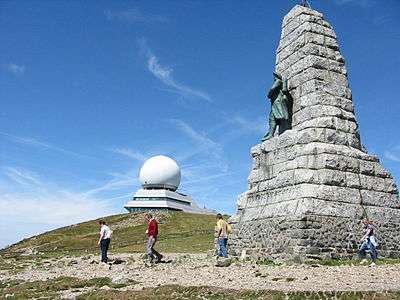 Monument on Grand Ballon |
The Sudel or Sudelkopf
| The Sudel or Sudelkopf |
|---|
| The Sudel is a 1,500 metre long ridge north of Hartmannswillerkopf and as with Hartmannswillerkopf it had French and German trenches along it.
There was not however the appalling loss of life that marked the Hartmannswillerkopf. The two front trenches in this area were often very close; the distance between the first lines of barbed wire and high voltage entanglements was at some points not more than 100 metres. The French 7th Infantry Regiment and the 5th Battalion of Chasseurs Alpins occupied the summit and the German Reserve Jäger Bataillon 8 was positioned on the southern slopes of the Sudel.[11] |
The chapel at the Sudelkopf
| The chapel at the Sudelkopf |
|---|
At Sudelkopf there is a small French National Memorial Chapel. The chapel has been built on the location of a French observation and machine gun post and a plaque tells us that "This chapel is dedicated to JEANNE d’ARC and has been erected in 1951 by SOUVENIR FRANCAIS, in memory to the French soldiers, who died during the 1st World War on this ridge bathed in floods of blood, who served at the observation post for the 7th Infantry Regiment and the 5th Battalion of “Chasseurs”, who defended the access to the valley of Thann. "For us the memory of their immortality.” The chapel at Sudelkopf |
The Col Amic and the memorial to Captain Amic
| Description of the Col Amic and the memorial to Captain Amic |
|---|
On the Col Amic near to Hartmannswillerkopf is a memorial to Captain Paul Amic who.was killed at Hartmannswillerkopf. Before the war this peak was known as the Kohlschlag but was renamed "Amic" by French. The inscription reads " A la mémoire de Paul Amic 1889-1915, Capitaine au 15e Bataillon de Chasseurs, Chevalier de la Légion d'Honneur, Croix de Guerre, Mort pour la France à la tête de sa compagnie à l'assaut de l'Hartmannswillerkopf le 21 décembre 1915. Si je meurs mes amis d'espoirs et de misère, vous m'ensevelirez près du front dans la terre sous la croix de sapin près du clocher flambé, mais gardez-moi le sol où je serai tombé. - Paul Amic, Moosch 1915 - Le Souvenir Français" From the Col Amic we move to the Col du Siberloch and the Hartmannswillkopf or Vieil Armand. |
Hartmannswillerkopf
| Description of Hartmannswillerkopf |
|---|
| The summit of the Hartmannswillerkopf or Vieil Armand as it was called by General Serrat was strategically important to both French and Germans. From the peak there were sweeping views of the Alsatian plain and the pass at Belfort and from it one could monitor any movement of troops. The peak is over 3,100 feet (940 metres) high and on a clear day one can see the Rhine, and the mountain ranges of the Hartz and Black Forest. The Jura mountains can be seen to the south and on a really clear day the Swiss Alps are visible. Whilst there was always trench to trench fighting in the area the actual battle of Hartmannswillerkopf started on 25 December 1914 when the 28th Battalion Chasseurs a Pied dug in on the summit and this led to German attacks on 4 January 1915. Attacks and counterattacks followed for twelve months until January 1916 and during this time territory changed hands frequently. After January 1916 the front line settled down and there was no major action until the war ended. The death toll from the Hartmannswillerkopf was high and it has been estimated that some thirty thousand Frenchmen were killed and, of course, a huge number of Germans.
In order to supply their troops on the Hartmannswillerkopf, the Germans built several camps on the Alsatian plain with many blockhouses and the area from Mulhouse to Hartmannswillerkopf is littered with the remains of German fortifications. Monument dedicated to the "Diables Rouges" ("Red Devils") as the 152nd Infantry Regiment were known The National Monument of the Hartmannswillerkopf was inaugurated on 9 October 1932. It consists of a crypt carved out of the bedrock. The entrance is approached by a cutting from the road and is flanked by two bronze representations of victory by the sculptor Antoine Bourdelle. Inside the crypt and covered by a large bronze shield is an ossuary which contains the remains of 12,000 unidentified soldiers. There are also Protestant and Jewish altars and a Catholic chapel. On the esplanade, which is situated above the crypt, is the Altar de la Patrie. This symbolises the raising of volunteers en masse for the defence of France and the Republic. It bears on its sides the names of the cities which contributed to the building of the memorial. Behind this crypt is a French Military Cemetery which contains 1,640 soldiers of whom the remains of 384 are in six ossuaries. Near to this cemetery is the monument dedicated to the "Diables Rouges" ("Red Devils") as the 152nd Infantry Regiment were known. This bronze depicts five larger-than-life-size soldiers all in attacking mode. The sculpture is mounted on a sheer rock face so that the figures can appear to be looking out over the Alsace plain. 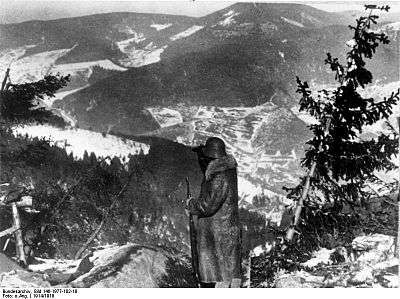 German soldier on Hartmannsweilerkopf |
French National War Cemetery at Moosch
| The French National War Cemetery at Moosch |
|---|
| The cemetery contains the bodies of 593 French soldiers many of whom were killed at Hartsmannerwiller. The cemetery holds the graves of General Serret, Captain Amic and Richard Hall of the American Ambulance Field Service.
General Serret commanded the 66th Mountain Infantry (Infanterie de Montagne) which fought at Hartmannswillerkopf. He was killed on 6 January 1916. [13] 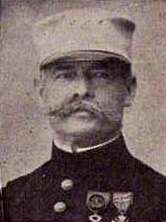 General Serret |
Thann
| Monument in Thann to the 66th Division of Chasseurs |
|---|
| In Thann there is a monument dedicated to the soldiers of the 66th Division of Chasseurs. It stands in Thann's Place de la République.
The main inscription reads "A "L'Alsacienne" - 66e division de Chasseurs dont le sang a coulé sur cette terre d'Alsace et à son dernier chef le général Brissaud-Desmaillets" Also inscribed on the monument are the words spoken by Joffre at Thann on 24 November 1914 ""Notre retour est définitif. Vous êtes Français pour toujours. La France vous apporte, avec les libertés qu'elle a toujours représentées, le respect de vos libertés à vous, des libertés alsaciennes, de vos traditions, de vos convictions, de vos moeurs. Je suis la France. Vous êtes l'Alsace. Je vous apporte le baiser de la France" |
French War cemetery at Altkirch
| French War cemetery at Altkirch |
|---|
| This cemetery at Altkirch in the Haut-Rhin contains the remains of 1,785 soldiers from the 1914-1918 war. 1,734 are Frenchmen of whom 912 lie in two ossuaries. The cemetery was created in 1920 to receive bodies from fighting south east of Mulhouse and from the village areas of Ballersdorf, Friesen, Illzach, Lutterbach, Sirentz and Zillisheim.[14] |
The Memorial at Joncherey
| Description of the Memorial at Joncherey |
|---|
| Joncherey is where the first casualties of the war on the Western Front occurred in one of the border incidents that preceded the formal declarations of war. At the eastern edge of the village is a monument to Corporal Jules Peugeot who was killed at 10am on 2 August 1914, 30 hours before war was declared between France and Germany. He was the first French casualty of the war and died just in front of the house which stands across the road from the monument. His patrol from the 44th Infantry Regiment was surprised by and fired upon by a patrol of seven German cavalrymen. The first German casualty, a Lieutenant Mayer of Ilfurth, was killed in the same incident.[15] |
The end of the line-Pfetterhouse
| Pfetterhouse |
|---|
| Not far from Pfetterhouse on the Franco-Swiss border the Western Front ends and in the surrounding woods there are some vestiges of that Front Line with the odd crumbled pillar box. Below is a photograph of the Monument aux Mort in the village. After the miles of killing fields that had been passed along the line of the Western Front, through the Yser region, through Flanders, through Artois, through the Somme, through the Chemin des Dames, St Mihiel, The Argonne, and Lorraine, the word "PAX" did indeed seem appropriate. It was however sad to recall that the fighting and killing would start all over again in 1939![16] |
See also
- List of World War I memorials and cemeteries in Artois
- List of World War I memorials and cemeteries in Champagne-Ardennes
- List of World War I memorials and cemeteries in Flanders
- List of World War I Memorials and Cemeteries in Lorraine
- List of World War I memorials and cemeteries in the Somme
- List of World War I memorials and cemeteries in Verdun
- List of World War I memorials and cemeteries in the area of the St Mihiel salient
References
- ↑ The French cemetery atSaulcy-sur-Meurthe Aufildesmotsetdelhistoire.unblog.fr. Retrieved 21 February 2013
- ↑ Soldier chosen for Tomb of Unknown Soldier Retrieved 21 February 2013
- ↑ The French cemetery at Saulcy-sur-Meurthe Memorial GenWeb. Retrieved 21 February 2013
- ↑ Lapoutrie Memorial GenWeb. Retrieved 21 February 2013
- ↑ General Bataille memorial pierreswesternfront.punt.nl. Retrieved 24 February 2013
- ↑ Tête des Faux www.lieux-insolites.fr. Retrieved 24 February 2013
- ↑ Battle of Linge Official website. 22 February 2013
- ↑ The Battle of Linge www.lieux-insolites.fr. Retrieved 21 August 2013
- ↑ Croix de Wihr www.lieux-insolites.fr. Retrieved 21 February 2013
- ↑ The memorial called"Armistice" www.lieux-insolites.fr. Retrieved 21 August 2013
- ↑ Sudelkopf pierreswesternfront.punt.nl. Retrieved 25 February 2013
- ↑ Monument to Captain Amic Memorial GenWeb. Retrieved 22 February 2013
- ↑ French National War Cemetery at Moosch Memorial Genweb. Retrieved 22 February 2013
- ↑ French War cemetery at Altkirch Mémorial GenWeb. Retrieved 19 February 2013
- ↑ Joncherey Joncherey website. Retrieved 25 February 2013
- ↑ Pfetterhouse Pfetterhouse website. Retrieved 25 February 2013
Further reading
- Tuchman, Barbara (1962). The Guns of August. Constable. ISBN 0-333-69880-0.
- MilitaryHistoryWiki.org. "The Battle of Mulhouse". MilitaryHistoryWiki.org. Archived from the original on 20 September 2008. Retrieved 2008-09-24.
Gallery
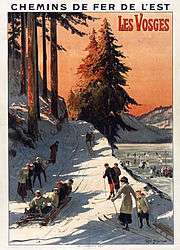 Poster for Vosges in happier days.
Poster for Vosges in happier days.- German Military cemetery at Thanvillé.
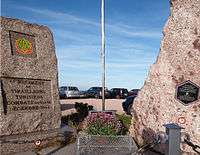 Memorial on the Hohneck to Tunisian soldiers.
Memorial on the Hohneck to Tunisian soldiers.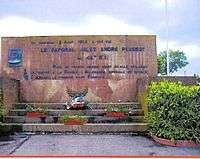 Memorial at Joncherry to the first Frenchman killed in 1914.
Memorial at Joncherry to the first Frenchman killed in 1914.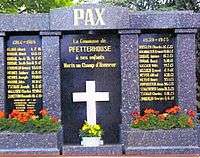 War Memorial at Pfetterhouse- The last along the Western Front.
War Memorial at Pfetterhouse- The last along the Western Front.- Bois de Maettlé cemetery near Sondernach.
.jpg) Cemetery at the Col de Sainte-Marie.
Cemetery at the Col de Sainte-Marie.- War memorial at Sainte Marie-aux-Mines.
- German graves at Saulcy-sur-Meurthe
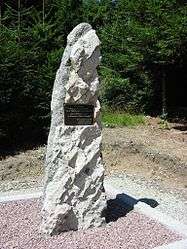 Memorial at Sainte-Marie-aux-Mines which commemorates the conquest of the Tête du Violu on 31 October 1914 by the 28th Battalion of the chasseurs alpins. Lieutenant Colonell Brissaud-Desmaillet led the attack.
Memorial at Sainte-Marie-aux-Mines which commemorates the conquest of the Tête du Violu on 31 October 1914 by the 28th Battalion of the chasseurs alpins. Lieutenant Colonell Brissaud-Desmaillet led the attack.- The French Military Cemetery at Chêne-Millet.
 The crypt at Hartmannswillerkopf.
The crypt at Hartmannswillerkopf..jpg) Thann in 1915 after German artillery bombardment.
Thann in 1915 after German artillery bombardment.